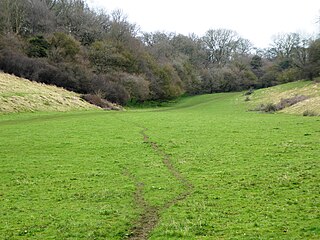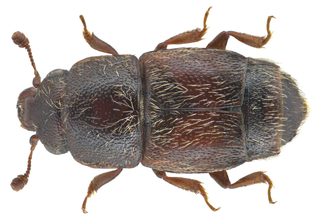
The false cleanerfish is a species of combtooth blenny, a mimic that copies both the dance and appearance of Labroides dimidiatus, a similarly colored species of cleaner wrasse. It likely mimics that species to avoid predation, as well to occasionally bite the fins of its victims rather than consume parasites. Most veiled attacks occur on juvenile fish, as adults that have been attacked in the past may avoid or even attack A. taeniatus.

Nicodamidae is a family of araneomorph spiders with about thirty species in seven genera. They are small to medium-sized spiders found near the ground of eucalypt forest in small sheet webs. The species of this family are only present in Australia and Papua New Guinea. In most cases the cephalothorax and legs are uniformly red and the abdomen black, for which these species are sometimes called the "red and black spider".

The soft-spined Atlantic spiny-rat, Trinomys dimidiatus, is a spiny rat species from South America. It is endemic to Brazil.

Oryzomys dimidiatus, also known as the Nicaraguan oryzomys, Thomas's rice rat, or Nicaraguan rice rat, is a rodent in the genus Oryzomys of the family Cricetidae. It is known from only three specimens, all collected in southeastern Nicaragua since 1904. Placed in Nectomys upon its discovery, it was later classified in its own subgenus of Oryzomys and finally recognized as closely related to other species now placed in Oryzomys, including the marsh rice rat and Oryzomys couesi, which occurs in the same region.

The bluestreak cleaner wrasse, Labroides dimidiatus, is one of several species of cleaner wrasses found on coral reefs from Eastern Africa and the Red Sea to French Polynesia. Like other cleaner wrasses, it eats parasites and dead tissue off larger fishes' skin in a mutualistic relationship that provides food and protection for the wrasse, and considerable health benefits for the other fishes.

Crossocerus is a genus of square-headed wasps in the family Crabronidae. There are at least 250 described species in Crossocerus.

Great Shuttlesfield Down is a 21.8-hectare (54-acre) biological Site of Special Scientific Interest north of Folkestone in Kent.
Crossocerus impressifrons is a species of square-headed wasp in the family Crabronidae. It is found in North America.

Crossocerus nitidiventris is a species of square-headed wasp in the family Crabronidae. It is found in North America.

Carpophilus dimidiatus, the cornsap beetle, is a species of sap-feeding beetle in the family Nitidulidae. It is found in Oceania, Europe, and North America.

Crossocerus cetratus is a Palearctic species of wasp.

Crossocerus elongatulus is a Palearctic species of solitary wasp.

Crossocerus podagricus is a Palearctic species of solitary wasp.
Crossocerus wesmaeli is a Palearctic species of solitary wasp.

Crossocerus palmipes is a Palearctic species of solitary wasp.
Crossocerus styrius is a Palearctic species of solitary wasp.
Crossocerus varus is a Palearctic species of solitary wasp.
Crossocerus walkeri is a Palearctic species of solitary wasp.












